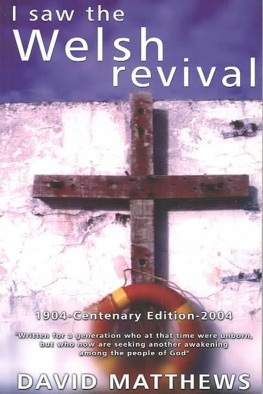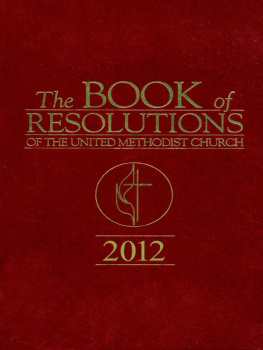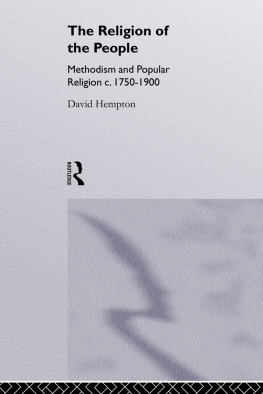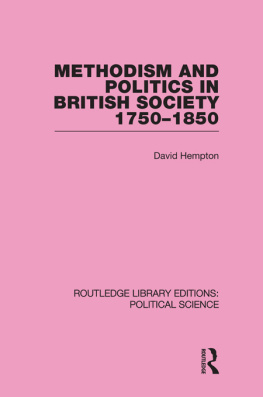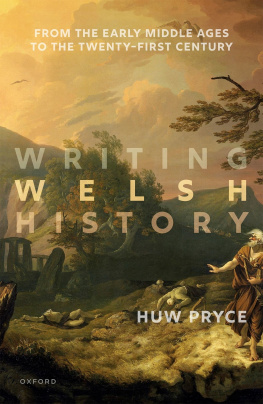Eryn M. White, 2020
All rights reserved. No part of this book may be reproduced in any material form (including photocopying or storing it in any medium by electronic means and whether or not transiently or incidentally to some other use of this publication) without the written permission of the copyright owner except in accordance with the provisions of the Copyright, Designs and Patents Act 1988. Applications for the copyright owners written permission to reproduce any part of this publication should be addressed to The University of Wales Press, University Registry, King Edward VII Avenue, Cardiff CF10 3NS
www.uwp.co.uk
British Library Cataloguing-in-Publication Data
A catalogue record for this book is available from the British Library.
ISBN 978-1-78683-579-6
e-ISBN 978-1-78683-581-9
The right of Eryn M. White to be identified as author of this work has been asserted by her in accordance with sections 77 and 79 of the Copyright, Designs and Patents Act 1988.
The publisher has no responsibility for the persistence or accuracy of URLs for any external or third-party internet websites referred to in this book, and does not guarantee that any content on such websites is, or will remain, accurate or appropriate.
Cover artwork and design by Clifford Hayes
The year 1737 saw the founding of the first permanent Methodist seiat in Wales, an institution which became intrinsically important in Welsh history and culture. Seiat was a word derived from the English society, but developed in Welsh exclusively in a religious context and very specifically for the Methodist fellowship meeting, sometimes referred to as seiat brofiad, an experience meeting. Although the Welsh word for society, cymdeithas, was used on some occasions, it was the word seiat which came to be adopted within the movement and beyond as the specific term for this particular type of meeting. The seiat developed as an institution in order to meet the needs of its members and could easily be adapted as circumstances demanded. Since it required no consecrated building and was not fixed to any precise spot, it could be held in whatever venue was available and could move as suited its members. All that was needed to begin with was two or three converts who chose to meet regularly. The flexible nature of the society meant that it was ideally suited to cater for the scattered rural communities of south-west Wales. By 1750, over 400 had been established throughout Wales, a substantial proportion of them within the three counties of the south-west, an area which was home to several of the early leaders of Methodism, and in convenient proximity to Howel Harriss base in Breconshire. One of the reasons for focusing specifically on this region is that it was identified at the time as the main centre of the revival, referred to by Harris as the Lords Peculiar Dwelling Place.
A good proportion of this Peculiar Dwelling Place in the three counties of south-west Wales Cardiganshire, Carmarthenshire and Pembrokeshire comprises coastal lowland. As David J. V. Jones has pointed out, contrary to first impressions, much of the land is under 1,000 feet,
This is the area which would become known as Rebeccas Country, centre of resistance to state and church during the Rebecca Riots in the mid-nineteenth century. It was a region much of which was not always the most productive agricultural land, which mostly did not develop large-scale industry and was largely not well served by communication networks. The south-west was overwhelmingly Welsh-speaking in the mid-eighteenth century, save for a greater degree of anglicisation in the market towns and the long-established Englishry of south Pembrokeshire, where the landsker cut a stark boundary between Welsh- and English-speaking communities. Despite the disadvantages, the south-western counties contained within the sprawling diocese of St Davids proved to be of crucial importance for some of the key educational and religious developments of the eighteenth century.
One of those developments was the evangelical revival, the history of which in Wales is closely associated with the three main early leaders: Daniel Rowland, Howel Harris and William Williams. Their contribution has traditionally been compartmentalised, with Rowland regarded as the inspired preacher, Harris as the capable organiser and Williams as the gifted hymnwriter. Although there is considerable truth in this depiction of their predominant talents, they each made a broader contribution to the development of the movement. These three are hailed as the founding fathers of Calvinistic Methodism in Wales, but others such as Howel Davies and Peter Williams also played important supporting roles, especially in the south-west. There was thus a group of leaders who discussed the progress of the movement and also consulted with those of like mind across the border. In the initial heady days of revival, there seemed to be an eagerness to share experiences and pool resources, which later cooled as doctrinal differences overcame the urge to cooperate. One of the major differences in outcome of the Welsh and English revivals was the relative strength of Arminian and Calvinistic Methodism, with the Arminian Methodism associated with the Wesleys proving slow to gain ground in Wales. Since Calvinism was quickly adopted as the theological stance in Wales, it was George Whitefield who was the main ally in England. He was appointed official moderator of the Welsh Association and Harris helped maintain his Tabernacle in London while he was away in America. There was a close degree of cooperation, therefore, as there was with the Countess of Huntingdons Connexion, also a Calvinistic branch of Methodism. Harris was the major contact with those other evangelical groups, maintaining links with the Wesleys and the Moravians as well as with the Calvinist wing of English-speaking Methodism. However, Welsh Methodism was not an offshoot of the English movement, but one of several streams of the evangelical revival which had emerged around the same time. One principle that united all of the Methodist groups in Wales and England was the commitment to remaining within the Church of England unless forced to leave. The Welsh Methodists were not forced to leave, but eventually chose to do so, forming the Calvinistic Methodist Church of Wales in 1811 and adopting the name Presbyterian Church of Wales in the twentieth century. Another outcome of the movement which is sometimes overlooked was an evangelical element which remained within the Anglican Church when the majority of Methodists departed.

This study concentrates on the early Methodist societies set up during the 1740s in south-west Wales. The main focus is the county of Carmarthenshire, but the movement itself did not necessarily think and plan in terms of county boundaries. As Howel Harriss map of his rounds reveals, the landscape was viewed according to where the centres of Methodist activity lay. The key geographical units for the purpose of this study are really the superintendencies set up to oversee groups of societies, which often crossed over county borders. William Richard, for instance had the care of the societies in south Cardiganshire and north Pembrokeshire, as well as a few societies in nearby Carmarthenshire. The Cardiganshire societies developed as two distinct groups: one in the Llangeitho/Tregaron area under the influence of Daniel Rowland and the other along the coastline around New Quay and Aberporth. Both had close links to Carmarthenshire and Pembrokeshire and form a natural part of this study. The societies in Welsh-speaking north Pembrokeshire had a closer affinity to those of south Cardiganshire and Carmarthenshire than with the English-medium societies to the south. They are therefore included here, but the south Pembrokeshire societies are not, as they were under separate supervision and the records for them are not as full. In essence, the area under consideration fell under the jurisdiction of five men: William John, John Richard, William Richard, James Williams, and William Williams of Pantycelyn. Morgan John Lewis also features since he was responsible for the society of Llanddeusant in east Carmarthenshire.


